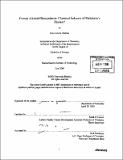| dc.contributor.advisor | Sarah O'Connor. | en_US |
| dc.contributor.author | Hatzios, Stavroula K. (Stavroula-Artemis K.) | en_US |
| dc.contributor.other | Massachusetts Institute of Technology. Dept. of Chemistry. | en_US |
| dc.date.accessioned | 2007-02-21T11:48:23Z | |
| dc.date.available | 2007-02-21T11:48:23Z | |
| dc.date.copyright | 2005 | en_US |
| dc.date.issued | 2005 | en_US |
| dc.identifier.uri | http://hdl.handle.net/1721.1/36162 | |
| dc.description | Thesis (S.B.)--Massachusetts Institute of Technology, Dept. of Chemistry, 2005. | en_US |
| dc.description | Includes bibliographical references (leaves 26-29). | en_US |
| dc.description.abstract | The occurrence of certain alkaloids in the human brain appears to be associated with the onset of Parkinson's disease (PD). Recently, a human protein bearing homology to an alkaloid synthase in plants was identified. This protein, termed BSCv, may catalyze alkaloid formation in humans. If such activity is confirmed, regulation of BSCv through the use of small molecule inhibitors could provide novel drug therapies for PD patients. This paper describes the first heterologous expression and purification of this transmembrane protein and examines its biological function through a series of enzyme assays. The assays used to evaluate enzyme activity were modeled after the Pictet-Spengler condensation catalyzed by the plant enzyme. Substrates were selected based on their potential to form alkaloids previously identified in central nervous system tissue. Product formation was monitored via high-performance liquid chromatography. Preliminary data suggest that BSCv does not function as an alkaloid synthase. However, further studies are needed to ascertain such conclusions. Alternative detergents should be evaluated to assess their influence on enzyme activity. The use of an expanded substrate pool may also provide insight into protein function since substrate specificity may have restricted product formation in the performed assays. Finally, incubation of BSCv with rat brain extract, which contains another species homologue of the protein, could provide insight into its natural substrates. If these studies are unsuccessful, consideration should be given to the possibility that BSCv may function as a receptor. Once the mechanistic and structural properties of the plant enzyme are elucidated, it may be possible to take a more direct approach to the characterization of its human homologue. | en_US |
| dc.description.statementofresponsibility | by Stavroula K. Hatzios. | en_US |
| dc.format.extent | 29 leaves | en_US |
| dc.language.iso | eng | en_US |
| dc.publisher | Massachusetts Institute of Technology | en_US |
| dc.rights | M.I.T. theses are protected by copyright. They may be viewed from this source for any purpose, but reproduction or distribution in any format is prohibited without written permission. See provided URL for inquiries about permission. | en_US |
| dc.rights.uri | http://dspace.mit.edu/handle/1721.1/7582 | |
| dc.subject | Chemistry. | en_US |
| dc.title | Human alkaloid biosynthesis : chemical inducers of Parkinson's disease? | en_US |
| dc.type | Thesis | en_US |
| dc.description.degree | S.B. | en_US |
| dc.contributor.department | Massachusetts Institute of Technology. Department of Chemistry | |
| dc.identifier.oclc | 73722077 | en_US |

